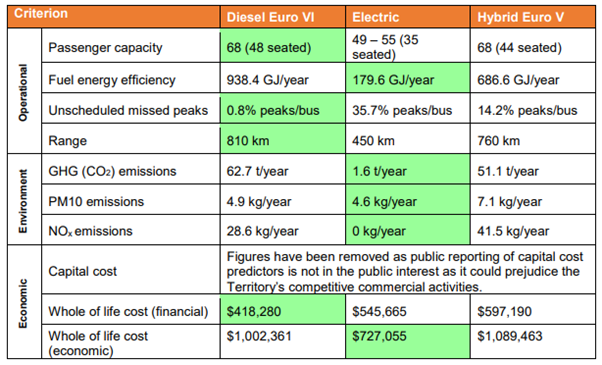An electric bus is powered by electricity via a battery (battery electric bus) or an external source (such as the trolley bus and contact with overhead wires). This article will focus on battery electric buses in Australia.
An electric vehicle fleet may include electric buses in order to meet emissions reductions targets by corporates and governments. The global stock of electric buses increased 25% in 2018 relative to 2017. [1]
Considerations of transitioning to an electric bus fleet
When considering electric buses, transit operators will need to consider:
- emissions reductions and delivery of renewable energy to ensure zero emissions
- electricity capacity of sites
- new depot configurations
- battery range of the vehicle
- impact of topography and climate on battery efficiency and range
- bus route optimisation
- charging management
- energy generation (such as onsite batteries and solar power)
- driver behaviour
- total cost of ownership based on balancing higher upfront cost with lower operating costs
Assessing the viability of transitioning to an electric bus fleet
This table highlights the key criteria the ACT Government used in the trial of Alternative Fuel Buses in the Transport Canberra Bus fleet to measure the viability of transitioning to an electric bus fleet: [2]

‘As with many new technologies, electric buses present new benefits and challenges. Some of these are highlighted below:
Benefits to operating an electric bus in Australia
- Environmental: An electric bus does not emit tailpipe emissions, reducing emissions profiles for CO2 and other harmful emissions (GHG, NOx and PM10).
- Health: A lack of tailpipe emissions reduces air pollution, resulting in cleaner air quality for communities. The electric drivetrain produces less noise and vibration than petrol or diesel engines, resulting in a quieter and more comfortable ride for the driver and passengers. This benefit can also be felt in the community, with reduced noise pollution as a result of traffic.
- Economic: Trials in Australia have shown that electric buses have lower whole of life economic costs as a result of their lower maintenance and refuelling costs. [3] Buses are also an economic way to reach emissions reductions targets, due to high utilisation and fuel replacement savings. [4]
- Grid integration: The integration of buses with large buses and onsite batteries and solar ad depots can be used to support the grid during periods of high demand. [5]
Challenges to operating an electric bus in Australia
- Capital cost: the upfront purchase price of an electric bus is higher than petrol and diesel alternatives.
- Passenger capacity: Bus passenger capacity is limited by heavy vehicle payload restrictions. The weight of a battery in an electric bus is higher than a tank of petrol and diesel, increasing the vehicles tare weight and reducing its payload capacity. Therefore, reducing the number of passengers an electric bus can carry.
- Upskilling: An electric bus will require new driver behaviour, procurement models, maintenance requirements and refuelling operations.
- Charging infrastructure investment and management: Additional assets investment is required to refuel electric buses via electric vehicle charging stations. This may also include electrical capacity upgrades for charger locations.
Charging an electric bus
The electrification of buses will require the installation of electric vehicle charging infrastructure. There are currently two models of EV bus charging being utilised globally:
| Advantages | Disadvantages | |
|---|---|---|
| Depot based charging Buses are charged overnight using on site electric vehicle charging infrastructure | Lower upfront capital cost | Potential grid limitations may require upgrade |
| Allows for off-peak charging | New depot and charging management | |
| Located on pre-owned property | Longer refuelling time | |
| On route charging Buses are charged via fast chargers along bus route | Smaller battery packs mean higher passenger count | More expensive and may require leasing/purchasing land |
| Greater flexibility in bus operations | Requires fast charging and may incur higher energy costs with DC grid integration | |
| Can compete more than one route with a rest period | Requires driver upskilling | |
| Note: a combined model approach may be appropriate | ||
Electric buses in Australia

